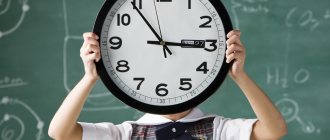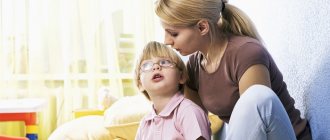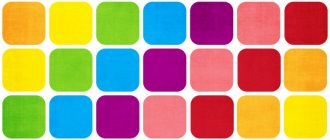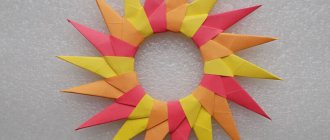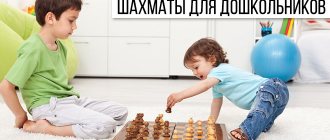How to teach children to identify the properties and characteristics of objects?
Khudyakova Elena Vyacheslavovna teacher MBOU "Aganskaya OSSH" preschool groups. Agan, Nizhnevartovsk district
The material was sent for publication in the All-Russian printed collection of practice-oriented materials “Preschool and primary education - modern methods and technologies of teaching and upbringing” - OCTOBER 2022.
HOW TO TEACH CHILDREN TO IDENTIFY THE PROPERTIES AND SIGNS OF OBJECTS?
- Abstract: The article discusses the following questions: how to gradually teach children to identify the properties and characteristics of objects.
- Key words: attribute of an object, property of an object
- Thematic heading: preschool education.
What is an item?
Advertising message
An object is all kinds of things around us, living beings, animals, plants, natural phenomena.
Each object has characteristics that distinguish it from another object.
Objects differ in color, shape, size, purpose, material from which they are made and other characteristics.
To determine the attribute of an object, you can ask the following questions:
- - Which?
- - which?
- -which?
- - which?
A sign is the presence or absence of a property in an object, as well as the presence or absence of a relationship between objects.
The attribute of an object is the way in which objects are similar to each other or how they differ from each other.
In everyday life, we teach our children to determine the properties of objects all the time, without noticing it. We ask, discuss and talk with the child (what color the object is, what shape it is, etc.).
So, let's try to highlight the essential features using the example of a lemon. Show your child this object (picture). Ask him to describe it, asking him questions; if the child finds it difficult, help him. What colour is he? “What shape?”, “What does it taste like?”, “What does it feel like?” Lemon: yellow, oval, sour, hard.
We teach children to identify the characteristics of an object by shape
Ask your child what shapes objects come in? (oval, round, square, rectangular).
You can offer your child, name and show objects of round, oval, square and rectangular shape. Or ask what figure the object resembles.
We teach children to identify the characteristics of an object by color
You can offer the child, name and show objects of red, yellow, green, etc. colors.
Ask your child what is green and what is blue? etc.
Thus, teaching a child to identify essential features by comparison should be done in stages:
- stage: Identify features or properties of one object.
- stage: Identify signs or properties of two objects
- stage: Identify signs or properties of three or more signs.
There are a lot of games and exercises for developing techniques for identifying features of an object. Let's look at a few of these games.
- Game "Guess who it is?"
Goal: development of an active vocabulary of adjectives denoting color, size, and qualitative characteristics of animals.
Progress of the game: an adult names several words (it is advisable to use mostly adjectives) describing this or that animal. The child’s task is to guess who they are talking about as quickly as possible.
More general descriptions should be given first. Then name more precise signs that are characteristic only of the hidden creature.
For example:
- Gray, angry, toothy, hungry. (wolf)
- Small, gray, cowardly, long-eared. (hare)
- Small, short-legged, hardworking, prickly. (hedgehog)
- Game "What is round?"
Here, of course, everyone knows what things are like here.
Purpose: To clarify children’s ideas about the size of objects; learn to classify objects according to a certain criterion (size, color, shape); develop quick thinking.
Progress of the game. Tossing the ball to children in various ways, the teacher asks a question to which the child, having caught the ball, must answer and then return the ball to the teacher. The teacher, in turn, passes the ball to the next child, waiting for an answer from him.
- What is round? (Ball, ball, wheel, sun, moon, apple, cherry...)
- What is long? (Road, river, rope, thread, tape, cord...)
- What is high? (Mountain, tree, man, hundred, house, closet...)
- What is green? (Grass, trees, bushes, grasshoppers, dress...)
- What happens when it's cold? (Water, snow, ice, dew, frost stone, night...)
- What is smooth? (Glass, mirror, stone, apple...)
- What's sweet? (Sugar, sweets, pies, cakes, waffles...)
- What is wool? (Dress, sweater, mittens, gloves, hat...)
- What is prickly? (Hedgehog, rose, cactus, needles, spruce wire...)
- What is spicy? (Knife, awl, glass, scissors, dagger, blade...)
- What's easy? (Fluff, feather, cotton wool, snowflake).
- What is deep? (Ditch, ditch, ravine, well, river, stream...)
3. Game “What dish is this?”
Goal: formation of relative adjectives in children’s speech.
- What soup made from... (beans, peas, fish, chicken, beets, mushrooms, vegetables)?
- What porridge is made from... (millet, rolled oats, semolina, buckwheat...)?
- What kind of jam is made from... (apples, plums, apricots, raspberries...)?
- What juice from... (carrots, pears, oranges...)?
- What kind of dishes are... (glass, metal, ceramic, porcelain, clay, plastic)? Give examples. Why is it called that? (glass - made of glass.)
- 4. Game “Name which one...”
Goal: formation of relative adjectives in children’s speech.
- The cabinet is made of wood, which means it is wooden.
- The bed is made of iron,…
- The sofa is made of leather,…
- The chair is made of plastic,…
Game "Say Otherwise"
Goal: expanding the dictionary of antonyms.
- Not sad children - ... (cheerful.)
- Not cold water - ... (warm.)
- Not a long rain - ... (short.)
- Not a dark sky - ... (light.)
- Not a rainy sky - ... (sunny.)
- Not bitter raspberries - ... (sweet.)
- Not low grass - ... (high.)
5. Game “Pick a sign”
Goal: agreement of adjectives with nouns.
- Doll (what?) - ..., ball (what?) - ...;
- Snow (what?) - ..., frost (what?) - ..., Icicle (what?) - ..., winter (what?);
- Summer (what?) – warm, bright, colorful, hot.
- The sun (what?) is yellow, hot, bright, warm.
- The grass in summer (what?) is green, fragrant, tall, short, soft.
- The water in summer (what?) is warm, cool, pleasant, refreshing.
- Rain in summer (what kind?) – warm, long-awaited, torrential, short, lingering.
- Children in the summer (what?) are cheerful, joyful, funny, tanned.
- The sky in summer (what?) is blue, bright, light, cloudless, stormy.
You can see the table of authors and learn more about the collections HERE
MAGAZINE Preschooler.RF
Topic: “Properties of objects.” Program content. 1. Form ideas about the signs of similarity and difference between objects. 2. Combine objects into groups - (based on similar characteristics) and select from the group individual objects that differ in some characteristic. 3. Develop children's connected speech. 4. Teach children to give reasons for their statements. 5. Continue teaching children to solve riddles. 6. Develop the ability to anticipate danger. Materials for the lesson: Demonstration - a picture of a bunny; Lotto pictures depicting fruits, flowers, vegetables; model of a basket of masks-hats of bunnies (for all) and foxes (one). Handout - cubes: five red and one yellow; bags or boxes for cubes. Contents of GCD. Organizing time. Mathematical warm-up. 1. Counting forward and backward 1 – 5. 2. Consolidating knowledge of numbers 1 – 5. I. Identifying signs of similarities and differences between objects. 1. Game: “Let’s Harvest.” —Who knows what time of year it is? (Autumn.) - What work is done in the garden and vegetable garden in the fall? (Vegetables and fruits are harvested in autumn). On the flannelgraph there is a model of a basket and pictures depicting flowers, fruits, and vegetables; picture with the image of a Bunny. — Our Bunny also decided to harvest from his garden. What did he put in his basket? Children, if desired, go to the flannelgraph and put pictures of vegetables in the basket. As the action progresses, you can ask questions: “What color are carrots? What shape is a cucumber? What size are radishes? What grows on earth? What grows underground? What grows above the ground? - Why didn’t you put chamomile? It can also grow in the garden, right? (Chamomile is a flower, and Bunny was collecting vegetables.). - Why is there an apple left? (An apple is a fruit, not a vegetable.) - What objects did you choose and on what basis? Because they're juicy? Large? Delicious? Are they used for food? (No. All these are vegetables, they grow in the garden.) 2) Game: “Magic bag”. On the tables the children have five red and one yellow cubes, and each a “magic bag” (a bag or box for the cubes). - What's on your tables? (Cubes.) - How are they similar and how are they different? (Same shape, size, all plastic. Different in color.) - What property distinguishes them from each other? (Color.) - Place cubes with the same properties in your “magic bag”. What cubes did you put in? What cubes are left? Why? (We put 5 red cubes - they have the same color, shape, size, material. There is a yellow cube left - it does not match the color). II. Physical education Stop, little bunny, don’t run along the narrow path. You’d better take care of your short little tail. The fox sneaks along the path. It’s unlikely he’s looking for mushrooms! One child depicts a sneaking fox, and the rest - running bunnies. The bunnies freeze, and then run away from the fox to their “house” places. III. Combining objects into groups according to a common property and separating from the group individual objects that differ in some property. - Guys, you have learned to find signs of similarity and difference among different objects. Let’s continue our journey with our Bunny: “let’s go” to the forest. I’ll tell you a few riddles and I think you’ll immediately guess what they’re about. Under the bushes, under the leaves We hid in the grass. Look for us in the forest yourself. We will not shout to you: “Ay!” (Mushrooms, berries.) - Name the berries shown in the first picture. (Raspberry, rowan, strawberry.) - What other berries do you know? Which of them grow in the forest, in the garden? Which ones grow only in the forest? (Blueberries, lingonberries, blueberries, cloudberries, etc.) - Who will be born wearing a hat? (Mushrooms.) - Name the mushrooms drawn in the picture. (White, honey mushrooms, fly agaric) - What do they have in common? (Each mushroom has a hat and a leg. They all grow in the forest.) - Which mushroom is the odd one out here and why? (Honey mushrooms always grow together, but fly agaric and white mushroom can grow alone; fly agaric is a poisonous mushroom, inedible, and the rest are edible). - Yes, indeed, there is even a poem about the fly agaric: It stands on the path On a thin leg, Covered with a colorful cap, Inedible, poisonous. - How many of you know why fly agaric is useful and for whom? (Amanitas can be eaten by moose. In folk medicine, fly agaric is used as a medicine - to prepare a rub). VI. Summary of the lesson. — The little hare was very glad to meet you. He really liked the stories of Sasha, Tanya, etc. about what grows and who lives in the forest. He is also happy about your gifts. Did you enjoy the trip with the Bunny?| Next > |
Abstract of GCD on FEMP on the topic: “Properties of objects”
Author: Apreleva Marina Gennadievna
Teacher of MBDOU CRR kindergarten No. 142 “Rosinka”, Ulyanovsk
Abstract of GCD on FEMP on the topic: “Properties of objects”
Municipal budgetary preschool educational institution "Kindergarten No. 142 "Rosinka"
Abstract of GCD on FEMP on the topic: “Properties of objects.”
Prepared by:
teacher
Apreleva M.G.
2020
Target:
To consolidate children's understanding of the properties of objects, the ability to find signs of their similarities and differences, to combine objects in a group according to a common characteristic (color, shape, size, material, purpose, etc.).
Tasks:
- Repeat and consolidate ideas about the shapes of geometric figures - square, circle, triangle, rectangle, oval.
- Develop attentiveness, creative imagination, ingenuity, the ability to substantiate your point of view, and draw conclusions.
- Develop the ability to work independently, develop self-control skills, and cultivate a friendly attitude towards each other.
Techniques used to guide children's activities:
Motivation
: surprise moment, commenting.
Activation of children's activities:
conversation, creating a developmental environment, posing a problematic question, solving a mathematical riddle.
Organization of practical activities:
showing illustrations, commenting, using the game “Geometric Shapes”, a mathematical riddle.
Motivation and maintaining interest:
surprise moment, situation of choice, physical activity, change of activities.
Assessment of children's activities, activation of self-esteem:
encouragement
Subject development environment for OOD:
models of geometric shapes: small and large red circles, small and large blue squares, large blue rhombus, large blue rectangle, large red oval, two small green triangles, large green equilateral triangle, large green equilateral triangle, large green isosceles triangle, rope with tied ends, an envelope with a “letter” from the Kingdom of Geometric Shapes, decorated with stickers of geometric shapes, a magnetic board.
Handout:
sheets of white paper, simple pencils, rulers with a stencil (geometric shapes)
Activities of children in OOD:
cognitive, gaming, communicative, motor.
Educational areas:
cognition (FEMP), physical development, communication, speech development.
OOD Plan
1.Introductory part – 2 min. Psychological mood. Surprise moment.
- Main part – 20 min. A conversation about the shapes of geometric figures. Didactic game "Geometric shapes". Dynamic pause "Wizards". Game "Characteristics and similarities of geometric shapes." Physical school
- Final part - 3 min. Physical education minute. Summing up the OOD. Assessment of children's activities.
Duration of OOD
– 25 min.
Progress of OOD
- Introductory part.
Psychological mood.
All the children gathered in a circle,
I am your friend and you are my friend
Let's hold hands tightly
And let's smile at each other.
IN:
I will smile at you, and you will smile at each other, so that you and I will have a good mood all day.
(pay attention to the envelope with the “letter” from the Kingdom of Geometric Figures)
IN:
Guys, look, we have received a letter. Let's read it.
“Dear guys! Marina Gennadievna, told me how well you know geometric shapes. That's why I decided to send you a game as a gift. I think you will definitely like it!
And of course, I invite you to visit me in the Kingdom of Geometric Shapes. See you soon!
Queen Mathematics"
IN:
Look at the blackboard. What do you see?
D:
geometric figures.
IN:
Let's remember the names of these geometric shapes.
Children name geometric shapes.
IN:
What do you know about this geometric figure?
(The teacher shows geometric shapes: square, triangle, circle, oval, rectangle
)
What is it called? How many angles does it have? How many sides? What shape does it have?
Children must name the color, size, shape.
- It's a little red circle.
- This is a small blue square.
- This is a small green triangle, etc.
- Main part.
Didactic game "Geometric shapes".
Let's look at our figures too
(pictures change on the board)
IN:
Please describe the changes that have occurred to the figures.
D:
the small red circle turned into a big red circle at first. The size has changed, but the shape and color have not changed.
And then the small red circle turned into a large red oval, the size and shape changed, but the color did not change.
D:
blue square. At first the size changed, the shape and color did not change.
Then the size and shape changed, but the color, number of corners and number of sides did not change.
Then the size and color changed, but the shape did not change.
D:
The same changes have occurred with the small green triangle. First the size changed, but the shape and color did not change.
Then the size and shape changed, but the color did not change. Then the size, shape and color changed, it turned into a large red square.
Dynamic pause "Wizards".
IN:
Have you seen what transformations took place with a circle, a square and a triangle. Now let’s play a little and build geometric shapes ourselves. For this we need this rope. I will show you a geometric figure, and you will all try to make it together.
(children stand in the center of the room, receive a rope with tied ends, take it with both hands and, at the teacher’s signal, form various geometric shapes. At the same time, the features of geometric shapes are repeated: an oval and a circle have no corners; a triangle has three angles and three sides, and a square and rectangle have four angles and four sides; A square has all sides equal, but a rectangle has only opposite sides.
).
Consolidating representations of the properties of objects.
Game "Characteristics and similarities of geometric shapes."
IN:
I have three envelopes with geometric shapes in my hands. You can identify the similarities and differences between these figures.
Sample answers from children:
D:
1) in the first envelope there are two blue figures. Both figures are blue, but one of them is a square, and the second is a circle. They differ in shape.
2) in the second envelope there are two triangles. They have the same shape and size. But these triangles have different colors: the first is red, the second is yellow.
3) the third envelope contains a rectangle and an oval. They have a common property - size. And they differ from each other in color and shape: the rectangle is green, and the oval is orange.
Physical exercise.
IN:
I will show you geometric shapes, and you perform the action that suits exactly this figure (
square - bends, triangle - turns, oval - squats, circle - jumps
).
Be careful.
Independent work.
Game "Orientation on a plane"
IN:
Now the task is on orientation on a plane. In front of you are sheets of white paper, simple pencils and stencil rulers with geometric shapes. Show me your right hand, now your left. Now show the upper right corner on a piece of paper. Now bottom left, etc. Your task, having seen the geometric figure that I will show, is to circle exactly in the corner where I say. We will do all this in silence. And at the end of the task, we will check whether everyone completed the task.
(the teacher shows a square and asks to circle it in the upper right corner, etc. with a circle, triangle, oval, rectangle
)
The task is completed independently.
IN:
what geometric figure is in the upper left corner? In the lower right? Etc.
- Final part.
IN:
Guys, what figures did we work with today?
How can we call them in one word?
What exactly did we do?
The geometric shapes are hidden so well in the group, let's find them.
(children find familiar geometric shapes in the environment. For example: a clock dial, window frames, etc.).
Reflection
.
IN:
What do you remember most today?
IN:
What was difficult for you? What was easy?
IN:
Appreciate your work with the help of the sun.
IN:
I think we did a good job today. Well done! Real experts in geometric shapes. It was a pleasure to play with you today.
